Presidents Diary
Printed in the Spring 2013 issue of Quest magazine.
Citation: Boyd, Tim. "Presidents Diary" Quest 101. 2 (Spring 2013): pg. 74 -75.
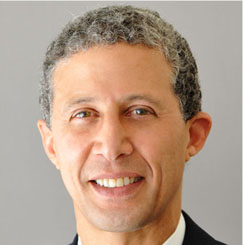 It is always difficult when good people leave us at Olcott. At the end of September longtime volunteer and all-around good guy Bill Vollrath and his wife moved to Virginia. Bill is a man with a big voice who manned the information desk one day each week. I could always count on a lively conversation and some down-to-earth common sense. He is missed.
It is always difficult when good people leave us at Olcott. At the end of September longtime volunteer and all-around good guy Bill Vollrath and his wife moved to Virginia. Bill is a man with a big voice who manned the information desk one day each week. I could always count on a lively conversation and some down-to-earth common sense. He is missed.
October was a travel month, this time to Mexico. A year ago the president of the Mexican section, Lissette Arroyo, had gotten in touch to see if I would be the presenter for their three-day Escuela de la Sabiduria ("School of the Wisdom"). In keeping with my habit, I said yes. This meeting is the equivalent of our Summer National Convention. Members from all around the country get together, they have a board of directors meeting before the school starts—the whole nine yards. The location for the get-together was in the small city of Cholula in an archaeological district. Our hotel and meeting room were within walking distance of one of the largest pyramid structures in the world and were surrounded by no less than four volcanoes—one still active. The area, which is in the state of Puebla and adjoins the city of that same name, is known for more than archaeology. It is regarded as the most religious state in Mexico. So all around us were Catholic churches, some of them exquisite. It is also famous for a particular style of ceramic—Talavera. Many of the church domes, interiors, and exteriors are ornamented in 400- and 500-year old tile. Because there are so many churches, each with its own patron saint, every day some local church was celebrating its patron. That part was OK. Unfortunately, however, one of the features of the celebration was that at random times throughout the day they would fire a cannon. The first time I became aware of it was at 4 a.m. on our first night. Talk about a rude awakening!
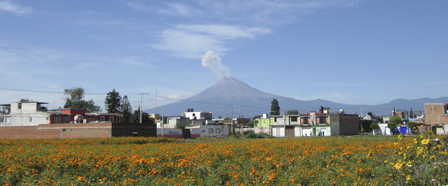 |
| The town of Cholua, Mexico. Popocatepeti volcano is in background. |
The conference was flawless. The local members from the Puebla branch had made the arrangements along with Lissette. Two of the members were former citizens of Switzerland who had been living in Mexico for more than three decades. It turns out that the largest Volkswagen plant outside of Germany is in Cholula. One of the members, Maria Mengelt, worked there as a translator. She arranged for two translators to come to the meeting and do simultaneous translation for my sessions. It was wonderful. All of the participants were equipped with earphones. I did not have to have a break in my thinking or speaking. (As much as I had been looking forward to making the trip, the thought of speaking, then waiting for someone to repeat my words, then picking up the speech again seemed a little cumbersome.) One of the translators, Guillermo, regularly works with former vice-president Al Gore when he is in Mexico. So I could be confident that any political or ecological references would be precise. Actually, Guillermo commented on how much he enjoyed this particular translation work. It was new to him. On our last day he invited his wife, who participated in the closing talks and discussions.
There was a social dimension to the meeting. On Saturday night a number of us gathered in a private room next to the hotel lounge for Turtulia— an evening of music, song, poetry, and dance. One of the local members and his wife brought his guitar, sound system, and a number of percussion instruments. We sang songs, told stories, played music, sang karaoke, and danced Cumbia into the night. It reminded me of the philosopher Nietzsche's remark, "We should consider every day lost on which we have not danced at least once," and the equally profound words of James Brown, "Any problem in the world can be solved by dancing." The body holds great wisdom—and dancing is fun.
The month closed out with our Halloween lunch. Each year I am more impressed with the creativity of staff, volunteers, and the kids at the Prairie School in thinking up new costumes. Everything from Harry Potter's Hagrid to Roaring Twenties haute couture, from ghoulish vampires to cops and firemen, was on display.
November found me in New York. As an ex-New Yorker I try to return on Thanksgiving to be with my family there. Lyn Trotman, our Eastern district director and president of the New York branch, is aware of this. So this year she contacted me to arrange for me to speak at their place. Their location is quite special. Right in the heart of midtown, on East 53rd Street, the lodge with its extensive library and the Quest Bookshop occupy two townhouses side by side. Every day people on lunch break from the surrounding businesses stop in to browse and talk. The center was made possible by the generosity of John and Emily Sellon and has been home to various Theosophical luminaries throughout the years including Emily Scion, Dora Kunz, Ed Abdill, Michael Gomes, and Anna Lemkow.
The talk was well attended, and we had some wonÂderful homemade confections afterward. For me it was a chance to meet new friends and spend time with peoÂple I have known for years. We decided to make it an annual event.
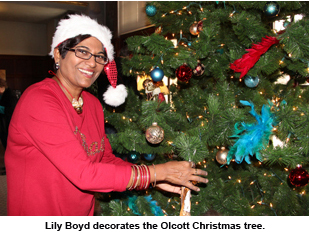 November festivities at Olcott included trimming the Christmas tree, which gathered staff and volunteers in the lobby to decorate our big tree. Some of the staff (including me) made some tasty cookies and snacks, the kids from the Prairie School came by and sang a couple of songs, and the whole feeling of Christmas filled the place.
November festivities at Olcott included trimming the Christmas tree, which gathered staff and volunteers in the lobby to decorate our big tree. Some of the staff (including me) made some tasty cookies and snacks, the kids from the Prairie School came by and sang a couple of songs, and the whole feeling of Christmas filled the place.
Also in November we celebrated Deepawali (also known as Diwali), the Indian festival of lights. My wife, Lily, and a crew of helpers put together a multiple-course Indian meal complete with samosas, mango lassi, and a variety of sweets. They also decorated NichÂolson Hall with candles, flowers, and the customary images of Lakshmi. Everyone who had anything Indian banging in their closet wore it, including the kids. It was a fun and quite colorful day
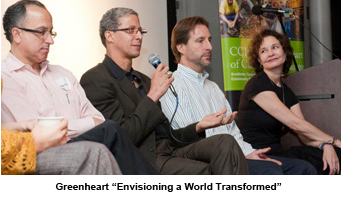 Later in the month Paula Finnegan, Juliana Cesano, my wife Lily, and I attended a remarkable event in Chicago. It was called "Envisioning a World Transformed" and was organized by a group called Greenheart. Greenheart is the brainchild of Emanuel Kuntzehnan, a visionary man who for years has been working to create a network of conscious individuals dedicated to quickening the planetary unfoldment of consciousness. (Emanuel contributed the article "Healing the Karmic Field" to the Fall 2012 issue of Quest.) The event was billed as "a day-long event featuring Chicago change-makers making a positive difference in their local communities. Listen throughout the day as presenters share their story of their 'tipping point,' when and how they decided to take the first steps in creating change, and inspire and motivate others to do the same." The range of speakers involved was impressive and included visionaries in a number of fields—education for global citizenship, social services, intuitive counseling, green architecture and business, and me representing a TheoÂsophical worldview. More than 200 people attended. There were also vendors from a variety of ecofriendly and socially responsible movements. It was an excelÂlent reminder of the growing movement of people who are waking up and taking responsibility for the future of the planet. It was also an opportunity to create links with kindred spirits.
Later in the month Paula Finnegan, Juliana Cesano, my wife Lily, and I attended a remarkable event in Chicago. It was called "Envisioning a World Transformed" and was organized by a group called Greenheart. Greenheart is the brainchild of Emanuel Kuntzehnan, a visionary man who for years has been working to create a network of conscious individuals dedicated to quickening the planetary unfoldment of consciousness. (Emanuel contributed the article "Healing the Karmic Field" to the Fall 2012 issue of Quest.) The event was billed as "a day-long event featuring Chicago change-makers making a positive difference in their local communities. Listen throughout the day as presenters share their story of their 'tipping point,' when and how they decided to take the first steps in creating change, and inspire and motivate others to do the same." The range of speakers involved was impressive and included visionaries in a number of fields—education for global citizenship, social services, intuitive counseling, green architecture and business, and me representing a TheoÂsophical worldview. More than 200 people attended. There were also vendors from a variety of ecofriendly and socially responsible movements. It was an excelÂlent reminder of the growing movement of people who are waking up and taking responsibility for the future of the planet. It was also an opportunity to create links with kindred spirits.
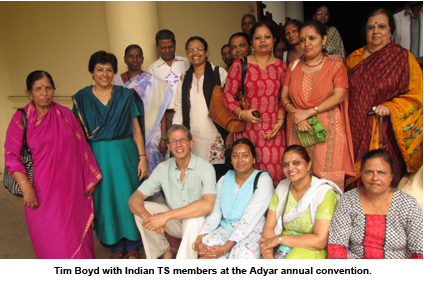 The year ended with me going to our Adyar international headquarters in Chennai, India. I attended the annual TS international convention. Our president, Radha Burnier, had asked me to address the convenÂtion, so on December 28 I spoke about "Theosophy and the Crowding World." The convention was attended by almost 1200 members, which is about the normal number for recent years. Radha was in good form. At the opening of the convention she announced that it is time to find a successor for her. She will be ninety this November and has served as president for thirty years, longer than any president in the TS's 138-year history.
The year ended with me going to our Adyar international headquarters in Chennai, India. I attended the annual TS international convention. Our president, Radha Burnier, had asked me to address the convenÂtion, so on December 28 I spoke about "Theosophy and the Crowding World." The convention was attended by almost 1200 members, which is about the normal number for recent years. Radha was in good form. At the opening of the convention she announced that it is time to find a successor for her. She will be ninety this November and has served as president for thirty years, longer than any president in the TS's 138-year history.
Tim Boyd


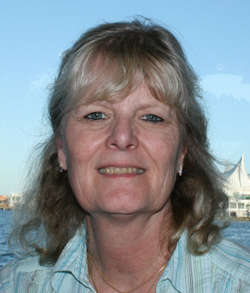 Love is a spontaneous feeling experienced not intellectually but emotionally. It can most easily be felt when seeing a child or animal—a feeling that simply takes over the person who is observing. It is a moment when all feels right with the world. Time no longer seems to exist, and the world feels as if it is moving in slow motion.
Love is a spontaneous feeling experienced not intellectually but emotionally. It can most easily be felt when seeing a child or animal—a feeling that simply takes over the person who is observing. It is a moment when all feels right with the world. Time no longer seems to exist, and the world feels as if it is moving in slow motion. 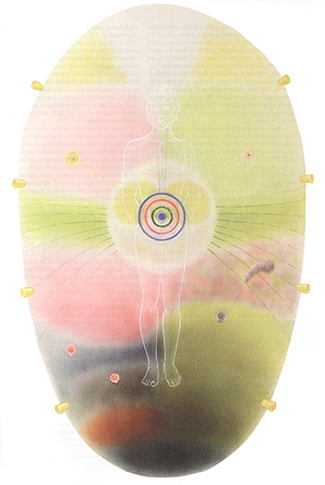 Let's look first at the representation of the aura of a pregnant woman. This plate shows the color of a delicate pink both above and below the green band at the woman's center. This represents both the love of her family and the love of the unborn child. Although this plate shows a woman who is seven months pregnant, even at an earlier stage the vibrational energy between mother and unborn child is quite similar. When I am looking at an actual pregnant woman, there is a distinct look of the child, seen as a large, whirling presence, a difficult look to create in a two-dimensional form. The colors of both mother and child complement each other.
Let's look first at the representation of the aura of a pregnant woman. This plate shows the color of a delicate pink both above and below the green band at the woman's center. This represents both the love of her family and the love of the unborn child. Although this plate shows a woman who is seven months pregnant, even at an earlier stage the vibrational energy between mother and unborn child is quite similar. When I am looking at an actual pregnant woman, there is a distinct look of the child, seen as a large, whirling presence, a difficult look to create in a two-dimensional form. The colors of both mother and child complement each other. 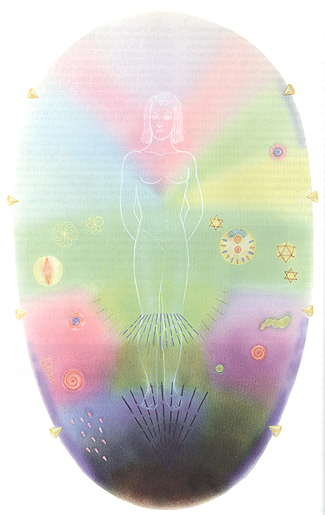 Another plate worth noting shows a painter. Notice the mixture of green with pink; the pink looks like a "V" intersecting her heart and head. This shows the individual's love, and the sheerness of the pink indicates that this is a love she can easily experience.
Another plate worth noting shows a painter. Notice the mixture of green with pink; the pink looks like a "V" intersecting her heart and head. This shows the individual's love, and the sheerness of the pink indicates that this is a love she can easily experience.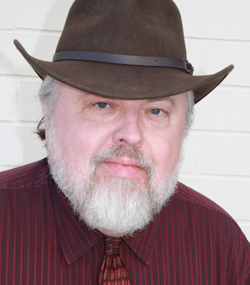 The Sanskrit word "kundalini" is literally translated as "coiled." The word is found principally in the lexicon of yogic and Tantric practice and refers to a latent energy or consciousness that resides at a point approximately at the base of the spine. It is usually pictured as either a "coiled serpent" or a "goddess." In either context it is considered feminine and is related to unconscious, instinctive, and/or libidinal forces.
The Sanskrit word "kundalini" is literally translated as "coiled." The word is found principally in the lexicon of yogic and Tantric practice and refers to a latent energy or consciousness that resides at a point approximately at the base of the spine. It is usually pictured as either a "coiled serpent" or a "goddess." In either context it is considered feminine and is related to unconscious, instinctive, and/or libidinal forces. 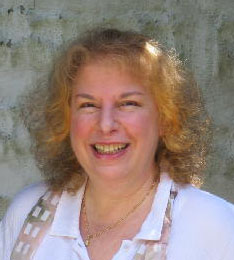 People tend to analyze love, calling it by various names: unconditional, patriotic, maternal, erotic, platonic, andsoon. Yet how can we accept any one aspect as a definition of love itself? If you are lucky enough to catch sight of a rainbow, you do not wish to stop and scrutinize where a certain color begins and another ends.
People tend to analyze love, calling it by various names: unconditional, patriotic, maternal, erotic, platonic, andsoon. Yet how can we accept any one aspect as a definition of love itself? If you are lucky enough to catch sight of a rainbow, you do not wish to stop and scrutinize where a certain color begins and another ends. 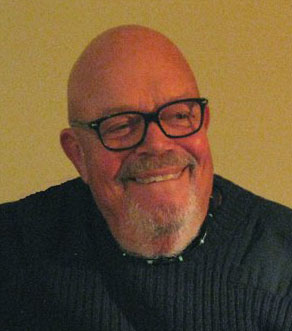 To sit down and write an article on love is a daunting task. With so many authors and great books providing interpretations of love and all that goes with it, who am Ito presume I can add to such a bibliography? Well, I'm a gay man who has experienced same-sex love.
To sit down and write an article on love is a daunting task. With so many authors and great books providing interpretations of love and all that goes with it, who am Ito presume I can add to such a bibliography? Well, I'm a gay man who has experienced same-sex love.